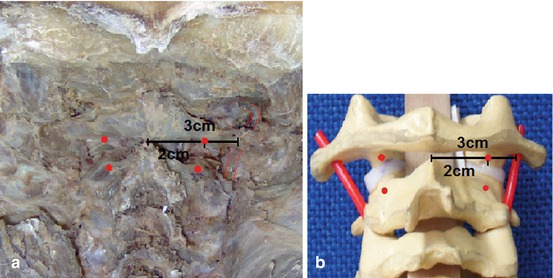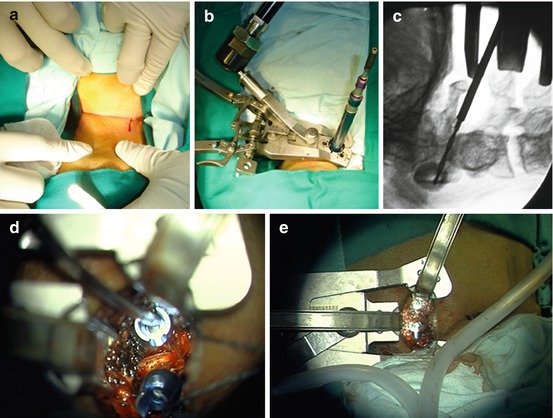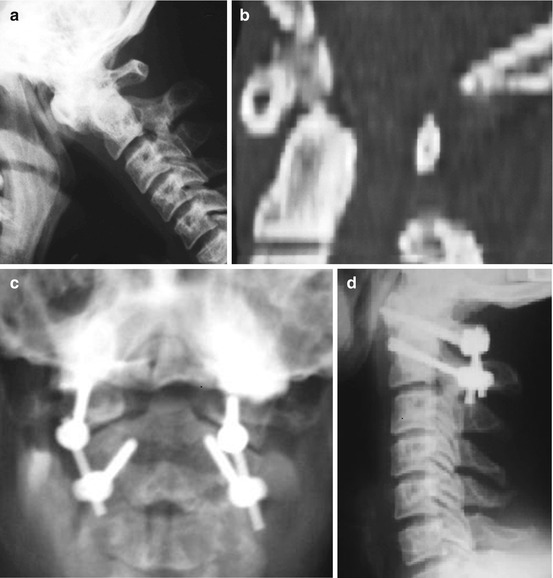Fig. 1
(a) Muscle anatomy of the cranio-cervical junction, we removed trapecius and semiespinalis capitis muscles, you can see an anatomical corridor between rectus capitis posterior maior and obliquus capitis inferior muscles. (b) Vertebral artery makes its way approximately 3 cm away midline during vertebral trjectory

Fig. 2
(a) Anatomical entry points of the screws using Harms’s technique (red points) (b) Representation in a cervical spine model of the screws entry points in red, you can see the trajectory of the vertebral artery, it is 1 cm approximately away of the screws
On the other hand, C1 lateral mass and C2 pedicles were measured, concluding that at least 3.5–4.0 mm diameter screws can be inserted, although this could vary from patient to patient making necessary an exhaustive preoperative evaluation and planning, and fluoroscopic confirmation during surgery [9, 10, 20].
Surgical Technique
To preserve the occipitocervical tension band, decreasing morbidity of traditional procedures, and less postoperative pain, we performed a prospective nonrandomized study starting in May 2007 [2] using a minimally invasive trans-muscular approach through a 2.5 cm bilateral paramedian skin incision (Fig. 3a), using the access MIS platform MaXcess® (NuVasive Inc., San Diego, CA, USA) (Fig. 3b), and subsequently placing screws according to the modified Harms technique (Fig. 3c).


Fig. 3
(a) Paramedian posterior cervical incisión (25mm aprox.). (b) Intraoperative image of the minimally invasive retractor Maxcess II® (Nuvasive Inc., San Diego, CA, USA. (c) Intraoperative x-ray image through the retractor during preparation of C1 screw using the tap. (d) Intraoperative close-up image of the screws through the retractor. (e) Intraoperative parnoramical view during the procedure
This approach uses a progressive tubular dilator system through the superficial nuchal musculature (trapezius and semispinalis capitis) and then through the anatomical corridor previously described between the posterior major rectus capitis and the inferior obliquus capitis. A three-valve spreader MaXcess® with optical fiber light is then placed, allowing good exposure and illumination of the working area (Fig. 3b). Under fluoroscopic guidance, the system is anchored on the access point of the C2 pedicle, trying to avoid obstaculization of the posterior arch of C1 during opening of the retractor. With monopolar cautery the bony surface of C2 is exposed, following it until the lateral border C1–C2 articulation is also visualized. At this point an epidural venous plexus usually bleeds, but it is effectively controlled with a combination of bipolar cautery and Gelfoam®. The C1–C2 bone joint surface is exposed and the C2 root identified and then coagulated and sacrificed to allow adequate insertion of the screw. At this point 3.5 mm diameter polyaxial screws are inserted using Harms technique (Fig. 3c, d). The articular surfaces of C1 and C2 are decorticated using micro-curettes and demineralized bone matrix (Grafton® DBM-Putty, Osteotech®, Inc. New Jersey, USA) mixed with bone marrow aspirates (BMA) is placed inside the joint to obtain second fusion (Fig. 3d, e). The same procedure is made in the contralateral side in the same way.
Clinical Experience
Until December 2011 a total of 16 patients were treated using this technique; mean age was 57.5 years old. Eight patients presented unstable C2 fracture and 8 patients atlantoaxial instability secondary to RA. Mean surgical time and blood loss was 193. 7 min and 403. 5 cc, respectively. Patients experienced minimal postoperative pain and were discharged before 46.8 h mean time; also there was no hardware failure.
Clinical Examples
Case 1
A 47-year-old male patient presented with posterior neck pain, occipital headache, and weakness on the left side of the body; 3 days previously the patient had fallen with cervical trauma in flexion.
Neurological exam showed pain on C2 dermatome bilaterally, 4/5 left hemiparesis without Babinski sign, and left patchy distribution hemihypoesthesia for superficial tact.
Cervical x-ray films showed dens fracture type II with instability (Fig. 4a, b).


Fig. 4
Case 1. (a) Preoperative lateral x-ray film shows type II dens fracture. (b) CT scan image confirms dens fracture. (c) post-operative AP x-ray view shows C1-C2 construction. (d) Post-operative lateral x-ray view of the construction
We performed a minimally invasive C1–C2 fusion procedure using polyaxial 3.5 mm diameter screws in both sides. No intraoperative complications occurred and blood loss was approximately 300 ml. Hospital stay was 43 h and the patient showed motor recovery in the early postoperative period (Fig. 4c, d). After 1 year of follow-up, the patient has neither pain nor weakness and instrumentation looks in good position.
Case 2
A 70-year-old female patient with 30 years history of rheumatoid arthritis, she had noticed a sensation of cervical instability and “cracking” during cervical motion, associated posterior neck pain irradiated to upper dorsal region, numbness, and weakness of the upper limbs.
On exam the patient had bilateral hyperreflexia, as well as Hoffman’s sign bilaterally without motor deficit. Magnetic resonance imaging (MRI) scans showed pannus odontoideum with posterior lens luxation and compression over the spinal cord without T2 signal of myelopathy. Dynamic x-ray films revealed that the atlantoodontoid interval reached more than 5 mm in length (Fig. 5a).


Fig. 5




Case 2. (a) Lateral x-ray image of the C1-C2 subluxation secondary to reumathoid arthitis. (b) Intraoperative lateral x-ray image shows C1-C2 screws implantation through the retractor. (c) Intraoperative lateral x-ray image of the final C1-C2 construction
Stay updated, free articles. Join our Telegram channel

Full access? Get Clinical Tree


